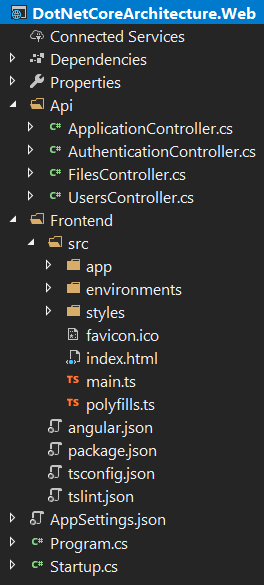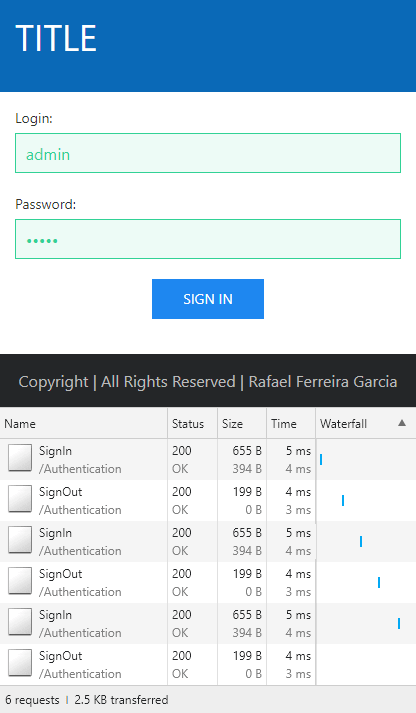DotNetCoreArchitecture
Architecture using new technologies and best practices to share knowledge and be used in new projects.
Technologies
- .NET Core 2.2.1
- C# 7.3
- ASP.NET Core 2.2.1
- Entity Framework Core 2.2.1
- Angular 7.2.2
- Typescript 3.2.4
- HTML
- CSS
- SASS
- UIkit
- JWT
- Swagger
- Docker
Practices
- Clean Code
- Ubiquitous Language
- DDD (Domain-Driven Design)
- SOLID Principles
- KISS Principle (Keep it simple, stupid)
- DRY Principle (Don't repeat yourself)
- YAGNI Principle (You aren't gonna need it)
- Without Over-Engineering
- Inversion of Control
- Dependency Injection
- Object Mapping
- Logging
- Response Caching
- Response Compression
- Code Analysis
- Cross-Platform
Tools
Nuget Packages
Source: https://github.com/rafaelfgx/DotNetCore
Published: https://www.nuget.org/profiles/rafaelfgx
Layers
Web: This layer contains the api (ASP.NET Core) and the frontend (Angular).
Application: This layer is the main entry point of the application.
Domain: This layer contains the requirements and the business logic.
Model: This layer is responsible for modeling the domain objects.
Database: This layer isolates and abstracts the logic for data persistence.
CrossCutting: This layer provides generic features for other layers.
IoC: This layer provides inversion of control for other layers.
Projects
Microservices Example
ASP.NET Core + Angular
ASP.NET Core Startup
public class Startup
{
public Startup(IHostingEnvironment environment)
{
Configuration = environment.Configuration();
Environment = environment;
}
private IConfiguration Configuration { get; }
private IHostingEnvironment Environment { get; }
public void Configure(IApplicationBuilder application)
{
application.UseExceptionDefault(Environment);
application.UseCorsDefault();
application.UseHstsDefault(Environment);
application.UseHttpsRedirection();
application.UseResponseCompression();
application.UseResponseCaching();
application.UseAuthentication();
application.UseStaticFiles();
application.UseMvcWithDefaultRoute();
application.UseHealthChecks("/healthz");
application.UseSwaggerDefault("api");
application.UseSpaStaticFiles();
application.UseSpaAngularServer(Environment, "Frontend", "serve");
}
public void ConfigureServices(IServiceCollection services)
{
services.AddDependencyInjection(Configuration);
services.AddCors();
services.AddResponseCompression();
services.AddResponseCaching();
services.AddAuthenticationDefault();
services.AddMvcDefault();
services.AddHealthChecks();
services.AddSwaggerDefault("api");
services.AddSpaStaticFiles("Frontend/dist");
}
}ASP.NET Core Controller
[ApiController]
[RouteController]
public class UsersController : ControllerBase
{
public UsersController(IUserApplication userApplication)
{
UserApplication = userApplication;
}
private IUserApplication UserApplication { get; }
[HttpPost]
public Task<IResult<long>> AddAsync(AddUserModel addUserModel)
{
return UserApplication.AddAsync(addUserModel);
}
[HttpDelete("{userId}")]
public Task<IResult<string>> DeleteAsync(long userId)
{
return UserApplication.DeleteAsync(userId);
}
[HttpGet]
public Task<IEnumerable<UserModel>> ListAsync()
{
return UserApplication.ListAsync();
}
[HttpGet("{userId}")]
public Task<UserModel> SelectAsync(long userId)
{
return UserApplication.SelectAsync(userId);
}
[HttpPut("{userId}")]
public Task<IResult<string>> UpdateAsync(long userId, UpdateUserModel updateUserModel)
{
updateUserModel.UserId = userId;
return UserApplication.UpdateAsync(updateUserModel);
}
}Application
public sealed class UserApplication : IUserApplication
{
public UserApplication(IUserDomain userDomain)
{
UserDomain = userDomain;
}
private IUserDomain UserDomain { get; }
public Task<IResult<long>> AddAsync(AddUserModel addUserModel)
{
return UserDomain.AddAsync(addUserModel);
}
public Task<IResult<string>> DeleteAsync(long userId)
{
return UserDomain.DeleteAsync(userId);
}
public Task<PagedList<UserModel>> ListAsync(PagedListParameters parameters)
{
return UserDomain.ListAsync(parameters);
}
public Task<IEnumerable<UserModel>> ListAsync()
{
return UserDomain.ListAsync();
}
public Task<UserModel> SelectAsync(long userId)
{
return UserDomain.SelectAsync(userId);
}
public Task<IResult<string>> UpdateAsync(UpdateUserModel updateUserModel)
{
return UserDomain.UpdateAsync(updateUserModel);
}
}Domain
public sealed class UserDomain : IUserDomain
{
public UserDomain(IDatabaseUnitOfWork databaseUnitOfWork, IUserRepository userRepository)
{
DatabaseUnitOfWork = databaseUnitOfWork;
UserRepository = userRepository;
}
private IDatabaseUnitOfWork DatabaseUnitOfWork { get; }
private IUserRepository UserRepository { get; }
public Task<IResult<long>> AddAsync(AddUserModel addUserModel)
{
var validationResult = new AddUserModelValidator().Valid(addUserModel);
if (!validationResult.Success)
{
return new ErrorResult<long>(validationResult.Message).ToTask();
}
var signInModel = new SignInModel(addUserModel.Login, addUserModel.Password);
addUserModel.Login = signInModel.LoginHash();
addUserModel.Password = signInModel.PasswordHash();
var userEntity = addUserModel.Map<UserEntity>();
UserRepository.Add(userEntity);
DatabaseUnitOfWork.SaveChanges();
return new SuccessResult<long>(userEntity.UserId).ToTask();
}
public Task<IResult<string>> DeleteAsync(long userId)
{
UserRepository.Delete(userId);
DatabaseUnitOfWork.SaveChanges();
return new SuccessResult<string>().ToTask();
}
public Task<PagedList<UserModel>> ListAsync(PagedListParameters parameters)
{
return UserRepository.ListAsync<UserModel>(parameters);
}
public Task<IEnumerable<UserModel>> ListAsync()
{
return UserRepository.ListAsync<UserModel>();
}
public Task<UserModel> SelectAsync(long userId)
{
return UserRepository.SelectAsync<UserModel>(userId);
}
public Task<IResult<string>> UpdateAsync(UpdateUserModel updateUserModel)
{
var validationResult = new UpdateUserModelValidator().Valid(updateUserModel);
if (!validationResult.Success)
{
return Task.FromResult(validationResult);
}
var userEntity = updateUserModel.Map<UserEntity>();
var userEntityDatabase = UserRepository.Select(userEntity.UserId);
userEntity.Login = userEntityDatabase.Login;
userEntity.Password = userEntityDatabase.Password;
UserRepository.Update(userEntity, userEntity.UserId);
DatabaseUnitOfWork.SaveChanges();
return new SuccessResult<string>().ToTask();
}
}Repository
public sealed class UserRepository : EntityFrameworkCoreRepository<UserEntity>, IUserRepository
{
public UserRepository(DatabaseContext context) : base(context) { }
public Task<SignedInModel> SignInAsync(SignInModel signInModel)
{
return SingleOrDefaultAsync<SignedInModel>
(
userEntity => userEntity.Login.Equals(signInModel.LoginHash())
&& userEntity.Password.Equals(signInModel.PasswordHash())
&& userEntity.Status == Status.Active
);
}
}Angular Guard
@Injectable()
export class AppGuard implements CanActivate {
constructor(
private readonly router: Router,
private readonly appTokenService: AppTokenService) { }
canActivate() {
if (this.appTokenService.any()) { return true; }
this.router.navigate(["/login"]);
return false;
}
}Angular Error Handler
@Injectable()
export class AppErrorHandler implements ErrorHandler {
constructor(private readonly injector: Injector) { }
handleError(error: any) {
if (!error.status) { return; }
const appModalService = this.injector.get(AppModalService);
const router = this.injector.get(Router);
switch (error.status) {
case 422: {
appModalService.alert(error.error);
break;
}
case 401: {
router.navigate(["/login"]);
break;
}
default: {
console.error(error);
break;
}
}
}
}Angular HTTP Interceptor
@Injectable()
export class AppHttpInterceptor implements HttpInterceptor {
constructor(private readonly appTokenService: AppTokenService) { }
intercept(request: HttpRequest<any>, next: HttpHandler) {
request = request.clone({
setHeaders: { Authorization: `Bearer ${this.appTokenService.get()}` }
});
return next.handle(request);
}
}Angular Service
@Injectable({ providedIn: "root" })
export class AppUserService {
constructor(private readonly http: HttpClient) { }
add(userModel: UserModel) {
return this.http.post(`Users`, userModel);
}
delete(userId: number) {
return this.http.delete(`Users/${userId}`);
}
list() {
return this.http.get(`Users`);
}
select(userId: number) {
return this.http.get(`Users/${userId}`);
}
update(userModel: UserModel) {
return this.http.put(`Users/${userModel.userId}`, userModel);
}
}Angular Component
@Component({ selector: "app-login", templateUrl: "./login.component.html" })
export class AppLoginComponent {
signInModel = new SignInModel();
constructor(private readonly appAuthenticationService: AppAuthenticationService) { }
ngSubmit() {
this.appAuthenticationService.signIn(this.signInModel);
}
}Performance
Specifications
Processor: Intel Core I7 8700K Coffee Lake 8th-generation.
Memory: 16GB 2400Mhz DDR4.
Storage: Samsung Evo 960 SSD M2 250gb.
OS: Windows 10 Pro 64 bits.
Web Server: Kestrel.
Database: SQL Server 2017 Developer Edition.
Swagger
Run Command Line
-
Install latest .NET Core SDK.
-
Open directory source\Web\Frontend in command line and execute npm run restore.
-
Open directory source\Web in command line and execute dotnet run.
-
Open https://localhost:8090.
Run Visual Studio Code
-
Install latest .NET Core SDK.
-
Install C# Extension.
-
Open directory source\Web\Frontend in command line and execute npm run restore.
-
Open source directory in Visual Studio Code.
-
Press F5.
Run Visual Studio 2017
-
Install latest .NET Core SDK.
-
Open directory source\Web\Frontend in command line and execute npm run restore.
-
Open source\DotNetCoreArchitecture.sln in Visual Studio.
-
Set DotNetCoreArchitecture.Web as startup project.
-
Press F5.
Run Docker
-
Install and configure Docker.
-
Execute docker-compose up --build -d --force-recreate in root directory.
-
Open http://localhost:8095.





